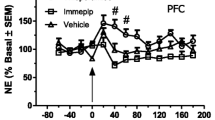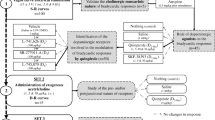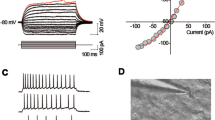Abstract.
To investigate whether H1 and H2 histamine receptors are implicated in the modulation of acetylcholine release by endogenous histamine, the ventral striatum of the conscious, freely moving rat was superfused by the push–pull superfusion technique with drugs and the release of acetylcholine was determined in the superfusate.
Superfusion with the H1 receptor agonist 2-thiazolylethylamine (TEA, 50 µmol/l) enhanced the release of acetylcholine, while the H1 receptor antagonist triprolidine (50 µmol/l) reduced acetylcholine outflow and abolished the TEA-evoked release of the neurotransmitter. The inhibitory effect of triprolidine was not influenced either on simultaneous superfusion with 10 µmol/l (±)-7-bromo-1-(fluoresceinylthioureido)phenyl-8-hydroxy-3-methyl-2,3,4,5-tetrahydro-1H-benzazepine (SKF-83566, D1 dopamine receptor antagonist) and 50 µmol/l quinpirole (D2/D3 dopamine receptor agonist) or on superfusion with the GABAA receptor antagonist bicuculline (50 µmol/l). The H2 receptor antagonists ranitidine or famotidine (50 µmol/l each) greatly enhanced acetylcholine release rate in the ventral striatum. Presuperfusion with α-fluoromethylhistidine (FMH, 1 mmol/l), which inhibits neuronal synthesis of histamine, abolished the famotidine-induced release of acetylcholine. The releasing effect of famotidine was also abolished on simultaneous superfusion with 10 µmol/l SKF-83566 and 50 µmol/l quinpirole. The release of acetylcholine elicited by famotidine was reversed to a decreased acetylcholine outflow when the striatum was superfused with the GABAA receptor antagonist bicuculline (50 µmol/l) prior to famotidine. Superfusion with the H2 receptor agonist impromidine (1 µmol/l) decreased acetylcholine outflow, while the H2 agonist dimaprit (50 µmol/l) exerted the opposite effect. The releasing effect of dimaprit was not influenced by FMH (1 mmol/l), but it was abolished in the presence of SKF-83566 (10 µmol/l) and quinpirole (50 µmol/l). In the presence of bicuculline the release of acetylcholine by dimaprit was enhanced and prolonged. It seems possible that dimaprit and impromidine stimulate different subtypes of H2 receptors.
The findings suggest that the release of acetylcholine in the striatum is modulated by neighbouring histaminergic neurons in a complex way. Stimulation of H1 histamine receptors, probably located on cholinergic neurons, enhances acetylcholine release. Stimulation by histamine of H2 receptors located on cholinergic or GABAergic neurons enhances the release of acetylcholine, while stimulation of H2 receptors located on dopaminergic neurons exerts the opposite effect.
Similar content being viewed by others
Author information
Authors and Affiliations
Additional information
Electronic Publication
Rights and permissions
About this article
Cite this article
Prast, H., Tran, M., Lamberti, C. et al. Histaminergic neurons modulate acetylcholine release in the ventral striatum: role of H1 and H2 histamine receptors. Naunyn-Schmiedeberg's Arch Pharmacol 360, 552–557 (1999). https://doi.org/10.1007/s002109900098
Received:
Accepted:
Issue Date:
DOI: https://doi.org/10.1007/s002109900098




